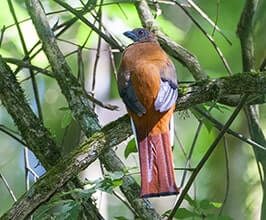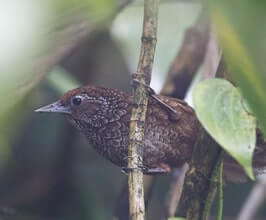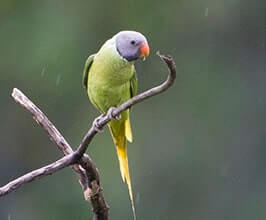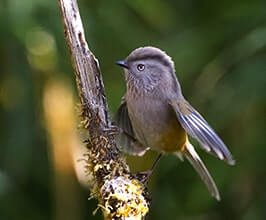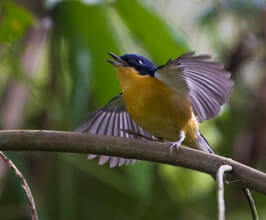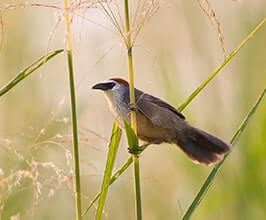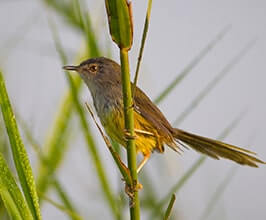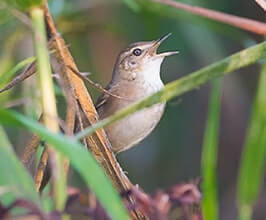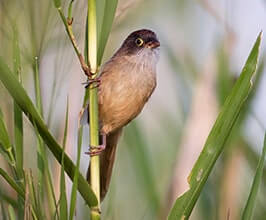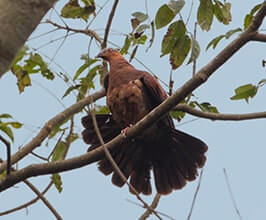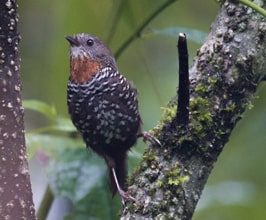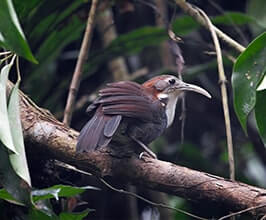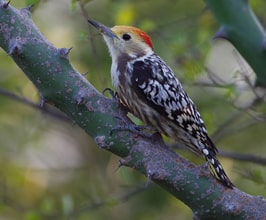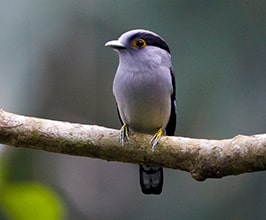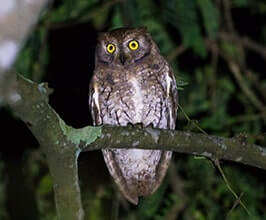Delhi – Dibrugarh – Mishmi Hills - Mayodia Pass - Roing - Tinsukia - Maguri Beel - Digboi - Dehing Patkai Wildlife Sanctuary - Jeypore Forest Range - Digboi – Dibrugarh
13 Days / 12 Nights
From the mountain passes of Himalayan foothills to the lowland rainforests of Northeast India, our Assam and Mishmi Hills Birding Tour covers a wide range of bird habitats known both for numbers and diversity of avian species. More Info
Booked as per
request.
Included except arrival and departure city.

Private guide for complete tour.
Airport to Airport.
2-8PAX
Included
From the mountain passes of Himalayan foothills to the lowland rainforests of Northeast India, our Assam and Mishmi Hills Birding Tour covers a wide range of bird habitats known both for numbers and diversity of avian species.
As a birdwatching destination, Northeast India has a tremendous potential most of which is still untapped. The many biodiversity hotspots of the two states of Arunachal Pradesh and Assam host a lion’s share of about 1300 bird species, both resident and migratory, found in India. In our birding tour of Assam and Mishmi Hills, we explore, over a period of 13 days, some of these birding hotspots of Northeast India.
We hit the ground running in India’s capital Delhi and take you to a short Delhi birding tour on the very first day. It’s more of a warm-up tour for the long and serious birding adventure ahead.
Our Northeast India birding begins with Arunachal Pradesh, right in the Mishmi Hills, where the eastern Himalayas meet with the Indo-Burmese mountain range. Starting out at lower elevation, we move towards the height of Mayodia Pass (2655m) as the tour progresses. Two full days are committed to birding at Mayodia Pass and two to the town of Roing at lower altitude, with evening spells of night birding thrown in for good measure.
The birds we target in Mishmi hills include Spot-breasted Babbler, White-bellied Erpornis, Blyth’s Leaf Warbler, Blue-winged Minla, Small Niltava, Ashy Bulbul, Striated Yuhina, Black Bulbul, Nepal Fulvetta, White-naped Yuhina, Whiskered Yuhina, Cachar Wedge-billed Wren Babbler, Mishmi Wren Babbler, Purple Cochua, Hill Partridge, Rufous-throated Partridge, Yellow-rumped Honeyguide, Chestnut-crowned Warbler, Black-faced Warbler, Red-faced Liocichla, Scalater's Monal, Blyth's Tragopan, Fulvous Parrotbill, Fire-tailed Myzornis, Pale-Capped Pigeon, Ward’s Trogon, Dark-sided Thrush, White-crested and Blue-winged Laughingthrush, apart from nocturnal birds such as Mountain Scops Owl and Himalayan Wood Owl.
Birding in Assam, by contrast, is a different experience altogether. We enter the second leg of our Assam and Mishmi Hills birding adventure with an excursion at a wetland called Maguri Beel, which abounds with gorgeous aquatic birds, including Bar-headed Goose, Cotton Pygmy-Goose, Garganey, Northern Shoveler, Gadwall, Falcated Duck, Eurasian Wigeon, Northern Pintail, Ferruginous Duck, Tufted Duck, Little Grebe, Baillon's Crake, Northern Lapwing, Little-ringed Plover, Pheasant-tailed Jacana, Bronze-winged Jacana, and many others.
The highpoint of the Assam birding tour comes at the Dehing Patkai region, which has India’s largest stretch of tropical lowland rainforests. For two consecutive days, we hike up and down the birding trails at Dehing Patkai Wildlife Sanctuary and Jeypore Forest range in search of magnificent avian specialties, such as Large Scimitar Babbler, Sultan Tit, Red-headed Trogon, Lesser and Greater Necklaced & Rufous-necked Laughingthrushes, Pale-capped Pigeon, Violet and Emerald Cuckoo, Silver-bellied and Long-tailed Broadbill, Pale Blue and Slaty Blue Flycatchers, Brown Hornbills, Streaked Spiderhunter, Rufous-throated Fulvetta, Dollar Bird, White-browed Piculet, Hodgson’s hawk Cuckoo, Yellow-vented Flowerpecker, Scarlet-backed Flowerpecker, and several others.
INDIA BIRDING TOURS has been dedicatedly focussed on Northeast India as the birdwatching destination of choice, and has, in this endeavour, developed several new birding trails and opened up new avenues for birding in Arunachal Pradesh and Assam. Our reach in the Northeast is far and deep as a result of many personal and professional birdwatching expeditions done by the company’s founders themselves. We bring these personal experiences to bear on the itinerary of our Assam and Mishmi Hills birdwatching trip.
Lodging: Our Assam and Arunachal birding adventure plays out at various birding hotspots of Northeast India, some of which are close to urban centres and some are in remote areas. The accommodation available on this trip ranges from 3-star to basic. At some far-off locations, we may stay in guest houses or campsites. Almost all lodgings are close to birding sites, and some of them are at scenic locations where birdwatching can be done even at a leisurely hour from your window or balcony. All accommodations have basic amenities and a comfortable bed.
Meals: Birdwatching can metaphorically be food and wine for many a birder, but the matters of the belly are, by no means, trivial for us. We ensure that you have the choice of both Indian and Western meals on the table, including your preference for vegetarian or meat-based food. On the occasions when we camp out or stay in guest houses, our kitchen staff takes over and cooks delicious food while following all hygienic practices. At remote places, cooking ingredients may be limited, and meals may be simpler, but doubtlessly yummy.
Tour Difficulty: Birding in Mishmi Hills of Arunachal Pradesh takes you to varying elevations, from a moderate altitude of 390 meters at Roing town to 2655 meters at Mayodia Pass. The terrain is mountainous and the birding trails either stretch uphill or downhill. You should be up to this challenge of high-altitude birding. For this reason, only people in the age bracket of 15 to 65 qualify for our Arunachal birding trip. Assam is comparatively easier, but there is no escaping the long walks in the field, while carrying your camera, binoculars, field guide and backpack.
Tour Extension: Northeast India has plenty of recreational opportunities to go with your birding holiday of Arunachal and Assam. You may want to go on a birding and wildlife safari at Kaziranga National Park in Assam. One-horned rhinoceroses are the biggest attraction of this park. Or you may want a holiday package to Shillong, also called the ‘Rock music capital of India’. Or you may like to check out the cultural hotspots closer to the birding locations in our itinerary. Whatever be your wish, just let us know well in advance so that we can make necessary arrangements for the tour extension you want.
Climate: The eight-month period from October to May is the best time to do our Assam and Mishmi Hills birding expedition. October to February is winter season in Arunachal and Assam. During these cold months, the temperature can drop to freezing in Arunachal and it hovers around 6-8 degrees in Assam. Winter-wear is recommended for birding tours done during this period. From March to May, the Northeast India witnesses pleasant spring and the temperature rises to double digits, but it never gets scorching hot. Summer-wear and light winterwear is recommended for the tours done during these months.
India’s capital Delhi is where our birding adventure of Assam and Arunachal begins. Our representative receives you at the airport or railway station in Delhi and drives you to a pre-booked hotel. After a short rest break, we take you out for a birding tour of Delhi.
A metropolis like Delhi may not come across as a birding destination at first glance, but the Okhla Bird Sanctuary, located at Okhla barrage on the outskirts of the city, quickly puts paid to such notions. As many as 300 bird species have been spotted here and our targets for the day include Eurasian Collared-Dove, Laughing Dove, Yellow-footed Green-Pigeon, Greater Coucal, Asian Koel, Grey-headed Swamphen, White-breasted Waterhen, Black-winged Stilt, Red-wattled Lapwing, Pheasant-tailed Jacana, Temminck's Stint, Wood Sandpiper, Whiskered Tern, Oriental Darter, Great Cormorant, Indian Cormorant, Grey Heron, Cattle Egret, Indian Pond-Heron, Black-headed Ibis, Black Kite, Spotted Owlet, Indian Grey Hornbill, Common Kingfisher, Green Bee-eater, Brown-headed Barbet, Rose-ringed Parakeet, Black Drongo, Long-tailed Shrike, Ashy Prinia, Plain Prinia, Sykes's Warbler, Clamorous Reed Warbler, Plain Martin, Red-whiskered Bulbul, Indian White-eye, Striated Babbler, Rosy Starling, Bank Myna, India Robin, Oriental Magpie-Robin, Bluethroat, Pied Bushchat, Citrine Wagtail, Paddyfield Pipit, and Red-headed Bunting.
In the evening we return to our hotel for dinner and overnight. We sleep early because we have an early start the day after.
Early in the morning, we transfer you to Delhi airport for a flight to Dibrugarh, an industrial city located in the north-eastern part of Assam, close to the state’s border with Arunachal Pradesh. Our driver or representative meets you at the Dibrugarh airport and drives you to the town called Roing in Arunachal Pradesh. The 150-km cab ride takes about 3 to 4 hours and the road winds through a beautiful landscape replete with birding opportunities.
We make the most of this journey by stopping over at selected birding sites along the way and look for the first sights of the birds of Arunachal Pradesh. These are only short halts as we want to make it to Roing in time to squeeze in some evening birding in the day’s schedule.
Roing is a small town situated at the foothills of Mishmi Hills. For someone travelling eastward along the length of Arunachal Pradesh, it is the last major town to India’s north-eastern border with China. From the birding point of view, Roing is a good place to start our birding tour of Arunachal Pradesh. After our arrival, we freshen up at a pre-booked resort and then step out for a short birding excursion in nearby areas. Dinner and overnight at the resort.
The subtropical evergreen forest of Mishmi Hills receives heavy rainfall every year and is a notable biodiversity hotspot for nature lovers to explore. We dedicate the whole day to birding in the lower areas of Mishmi Hills. There is an excellent birding trail that stretches up to a place called Tiwari Gaon, 20 km away. We drive up this trail and make regular stops to birdwatch.
Our targets for the day include Spot-breasted Babbler, White-bellied Erpornis, Blyth’s Leaf Warbler, Blue-winged Minla, Small Niltava, Ashy Bulbul, Striated Yuhina, Black Bulbul, Nepal Fulvetta, White-naped Yuhina, Whiskered Yuhina, Pygmy Cupwing, Streaked Spiderhunter, White-capped Redstart, Black-throated Sunbird, Collared Treepie, Scarlet Minivet, White-crested Laughingthrush, Long-tailed Sibia, Rufous-necked Laughingthrush, Yellow-bellied Warbler, Vivid Niltava, Pigmy Wren Babbler, Scaly Wren Babbler, Green Cochua, Large Blue Flycatcher, White-gorgeted Flycatcher, Fulvous-breasted Woodpecker, Great Barbet, Golden-throated Barbet, Large Hawk Cuckoo, Wedge-tailed Green Pigeon, Mountain Hawk Eagle, Maroon Oriole, Grey-chinned Minivet, Lesser Shortwing, White-tailed Robin, Beautiful Nuthatch, Fire-capped Tit, Yellow-cheeked Tit, Sultan Tit, Black-throated Tit, Striated Bulbul, Ashy Bulbul, Black Bulbul, Brownish-flanked Bush Warbler, Mountain Tailorbird, Blyth’s Leaf Warbler, Grey-hooded Warbler, Grey-cheeked Warbler, Lesser-necklaced Laughingthrush, Striated Laughingthrush, Blue-winged Laughingthrush, Red-faced Liocichla , Rusty-throated Wren Babbler, Pale-Headed Woodpecker and many more.
We wrap up the day’s birding at Mishmi Hills by looking for Hodgson’s Frogmouth in the evening. Later, we drive back to our resort in Roing for dinner and overnight.
After an early breakfast, we leave Roing for a 40-km drive to Mayodia Pass, which is a mountain pass and a popular tourist destination, particularly in the winters owing to its altitude of 2655 meters which gives stunning views of surrounding snow-capped peaks. Apart from scenic beauty, Mayodia is known as a bustling habitat of birds. Birders often tread the areas around Mayodia Pass for some special and rare avian sights.
We do the day’s birding along the road to Mayodia Pass. We look out for the likes of Cachar Wedge-billed Wren Babbler, Mishmi Wren Babbler, Purple Cochua, Hill Partridge, Rufous-throated Partridge, Yellow-rumped Honeyguide, Chestnut-crowned Warbler, Black-faced Warbler, Red-faced Liocichla, Long-billed Wren Babbler, Eyebrowed Wren Babbler, White-browed Shrike Babbler, Black-eared Shrike Babbler, Blyth Tragopan, Rufous-capped Babbler, Golden Babbler, Silver-eared Mesia, Red-billed Leiothrix, Cutia, Rusty-fronted Barwing, Rufous-winged Fulvetta, White-naped Yuhina, Rufous-vented Yuhina, White-bellied Yuhina, Beautiful Sibia, Long-tailed Sibia, Fire-breasted Flowerpecker, Scarlet-backed Flowerpecker, Black-throated Sunbird, Fire-tailed Sunbird, and Streaked Spiderhunter among many others.
The day’s birding ends with our arrival at Mayodia Pass. We check into a place called Coffee House for snacks, dinner and overnight.
Several birding trails around Mayodia Pass are worth exploring. A stroll deeper into the lower forests reveals a fascinating variety of bird species. The bamboo brakes that grow in profusion along the road surprise you with wonderful kind of birds. We head out to explore these birding sites right after breakfast.
Perseverance in these bird habitats rewards you with sights of Scalater's Monal, Blyth's Tragopan, Fulvous Parrotbill, Fire-tailed Myzornis, Pale-Capped Pigeon, Ward’s Trogon, Dark-sided Thrush, White-crested and Blue-winged Laughingthrush, Green and Purple Cochoa, Rusty-Bellied and Gould’s Shortwing, Beautiful Nuthatch, Mishmi Wren-Babbler, Slender-billed Scimitar-Babbler, Manipur Fulvetta, Fire-Tailed Myzornis, Scarlet- and Grey-Headed Bullfinch, Mountain Scops Owl, Black-throated Parrotbill, Darjeeling Woodpecker, Grey-sided, Spotted and Black-faced Laughingthrushes, White-browed and Rusty-bellied Shortwing. One of the prized sightings of the day could be that of the Leopard Cat.
The region so abounds with birds that we can continue birding well into the night and seek out Mountain Scops Owl and Himalayan Wood Owl.
We call it a day with simple but tasty dinner at Mayodia Pass. Overnight at Mayodia Pass.
We leave the heights of Mayodia Pass and drive back down to the lower areas of Roing town, which sits at the moderate elevation of 390 meters. The birding trails around Roing have tremendous potential and we give them two full days of our birding adventure of Arunachal Pradesh.
Scouring the lower and middle altitude areas hereabout, we hope to see a wide variety of birds, including Red-headed Trogon, Large Hawk Cuckoo, Fork-tailed Swift, Collared Owlet, Asian Barred Owlet, Eagle/fish Owl, Barred Cuckoo Dove, Lesser Shortwing, Little Pied Flycatcher, Sultan Tit, Black-throated Tit, Striated Bulbul, Red-whiskered Bulbul , Ashy-throated Warbler, Yellow-browed Warbler, Blyth’s Leaf Warbler, Grey-hooded Warbler, Grey-cheeked Warbler, Grey-headed Parakeet, Chestnut-crowned Warbler, Black-faced Warbler, Red-faced Liocichla, Long-billed Wren Babbler, Eyebrowed Wren Babbler, Scaly-breasted Wren Babbler, Pygmy Wren Babbler, Bar-winged Wren Babbler, Grey-throated Babbler, Silver-eared Mesia, White-browed Shrike Babbler, Black-eared Shrike Babbler, Chestnut-tailed Minla, Yellow-throated Fulvetta, Brown-throated Fulvetta, Streak-throated Fulvetta, Nepal Fulvetta, Sparrowhawk , Oriental Honey Buzzard, Orange-bellied Leafbird, Yellow-billed Blue Magpie, Common Green Magpie, Grey Treepie and many others.
Moving on to the birding trails in Roing grasslands, we aim to sight the likes of Golden-headed Cisticola, Paddyfield Warbler, Striated Grassbird, Himalayan Black Bulbul, Blyth's Leaf Warbler, Jerdon's Babbler, Black-breasted Parrotbill, Grey-throated Babbler, Marsh Babbler, Striated Babbler, Great Myna, Chinese Rubythroat, Siberian Stonechat, Scaly-breasted Munia and Rare Swamp Prinia. After a busy day of birding at Roing, we return to our resort for dinner and overnight.
We start the day with a short birding excursion around Roing before packing up and driving towards the town of Tinsukia in Assam. The 100-km ride usually takes up to 4 hours, and we stop by some birding locations on the way to mark off some local avian specialties. We check into a resort in Tinsukia around lunch time and, after a short break for rest, we go out for a birding tour of Tinsukia.
Tinsukia is an industrial town with a birding potential in the nearby forest areas and tea plantations. It’s these areas we search for some resident and migratory bird species. There are ample avian curiosities here to keep us busy through the evening. After dusk, we probe the woods for nocturnal birds such as Brown Hawk Owl, Oriental Scops Owl, and Long-eared Nightjar. Usually, it’s possible to see all three in the same evening.
After a short spell of night birding, we return to our resort at Tinsukia for dinner and overnight.
Maguri Beel is a large wetland area next to Dibru Saikhowa National Park. The marshes and grasslands at Maguri Beel teem with such an incredible variety of birds that BirdLife International has declared it an Important Birding Area (IBA).
After an early breakfast, we drive for about half an hour to reach Maguri Beel, which is just 12 km from Tinsukia. The wetlands of Maguri Beel abound with the likes of Bar-headed Goose, Cotton Pygmy-Goose, Garganey, Northern Shoveler, Gadwall, Falcated Duck, Eurasian Wigeon, Northern Pintail, Ferruginous Duck, Tufted Duck, Little Grebe, Baillon's Crake, Northern Lapwing, Little-ringed Plover, Pheasant-tailed Jacana, Bronze-winged Jacana, Grey-headed Lapwing, Temminck's Stint, Eastern Spot-billed Duck, Common Snipe, Wood Sandpiper, Asian Openbill, Lesser Adjutant, Glossy Ibis, Eastern Marsh-Harrier, Pied Harrier, and Paddyfield Warbler.
The grasslands of Maguri Beel reveal a bunch of rare and exotic birds such as Black-breasted Parrotbill, Marsh Babbler, Jerdon’s Bushchat, Chestnut-capped Babbler, Jerdon's Babbler, Baikal Bush Warbler, Swamp Prinia, Swamp Francolin, Grey-sided Bush Warbler, Speckled Piculet, Striped Tit-Babbler, Pale-capped Pigeon, Red-necked Falcon, Pale-chinned Flycatcher, White-tailed Rubythroat, Spot-winged Starling, Pale-footed Bush Warbler, Japanese Bush Warbler, Black-breasted Chestnut-crowned Bush Warbler, Spotted Bush Warbler, Paddyfield Warbler, Clamorous Reed Warbler, Thick-billed Warbler, Smoky Warbler, Chestnut-capped Babbler, Jerdon's Babbler, Black-faced Bunting, Streaked Weaver, Yellow-breasted Bunting and several other avian curiosities.
After a busy day of birding at Maguri Beel, we return to our resort in Tinsukia for dinner and overnight.
Digboi is a town in eastern Assam known for its oil fields. It’s here the first oil well in Asia was drilled way back in the 19th century. But what’s not equally well known about Digboi is that it is a superlative bird haven. There’s plenty of birding prospects in the lowland forests and pools around the oil fields.
We explore these areas after an hour’s ride from Tinsukia to Digboi in the morning. We seek out a wide variety of birds like White-winged Duck, White-cheeked Partridge, Chestnut-backed Laughingthrush, Grey Peacock Pheasant, Blue-bearded Bee-eater, Falcated Duck, Ferruginous Pochard, Bay Woodpecker, Wreathed Hornbill, Great Hornbill, Oriental Pied Hornbill, Red-headed Trogon, Stork-billed Kingfisher, Grey-headed Lapwing, Green-billed Malkoha, Pompadour Green Pigeon, Pin-tailed Green Pigeon, Green Imperial Pigeon, Daurian Redstart, Mountain Tailorbird, Besra, Mountain Hawk Eagle, Common Green Magpie, Grey Treepie, Collared Treepie, Black-winged Cuckooshrike, Lesser Racket-tailed Drongo, Large Woodshrike, Dark-sided Thrush, Black-breasted Thrush, Dusky Thrush, Rufous-gorgeted Flycatcher, Black-backed Forktail, Velvet-fronted Nuthatch, White-throated Bulbul, Ashy Bulbul, Grey-breasted Prinia, Chestnut-headed Tesia, Slaty-bellied Tesia, Grey-bellied Tesia, Brownish-flanked Bush Warbler, Tickell's Leaf Warbler, Greenish Warbler, Blyth's Leaf Warbler, Yellow-browed Warbler, Puff-throated Babbler, Pygmy Wren Babbler, Grey-throated Babbler, Striped-tit Babbler, White-hooded Babbler, Rufous-throated Fulvetta, Blyth's Pipit, and Olive-backed Pipit.
For the whole day we cover the birding trails around Digboi and return to our hotel for dinner and overnight.
India’s largest stretch of tropical lowland rainforests is found in Assam’s Dehing Patkai region which is so thick and diverse that it’s divided into three parts: Jeypore forest range, Upper Dehing West Block and Upper Dehing East Block. These forests are home to an incredible variety of birds and deserve at least two busy days of birding. During these two days, we focus on the birding trails at the Dehing Patkai Wildlife Sanctuary and Jeypore forest range. The sanctuary also abounds with wildlife and it’s not unusual to see Asian Elephants and Hoolock Gibbon.
Our avian targets during these excursions are Large Scimitar Babbler, Sultan Tit, Red-headed Trogon, Lesser and Greater Necklaced & Rufous-necked Laughingthrushes, Pale-capped Pigeon, Violet and Emerald Cuckoo, Silver-bellied and Long-tailed Broadbill, Pale Blue and Slaty Blue Flycatchers, Brown Hornbills, Streaked Spiderhunter, Rufous-throated Fulvetta, Dollar Bird, White-browed Piculet, Hodgson’s hawk Cuckoo, Yellow-vented Flowerpecker, Scarlet-backed Flowerpecker, Blue-throated Barbet, White-crowned Forktail, Red-winged Cuckoo, White-throated Bulbul, Ashy Bulbul, Grey-throated Babbler, White-browed Piculet, Rufous-throated Fulvetta, White-browed Shortwing, Lesser Shortwing, Blue-eared Kingfisher, White-tailed Blue Flycatcher, Pale blue Flycatcher, Ruby-cheeked Sunbird, White-hooded Babbler, Pied Falconet, White-spectacled Warbler, Streaked Wren-Babbler, White-browed Scimitar-Babbler, Pale-chinned Blue Flycatcher, Hooded Pitta and several others.
On both days, we drive from our hotel in Digboi and return in the evening for dinner and overnight.
In the morning, we drive you for about 2 hours from Digboi to Dibrugarh. We drop you at the airport for your onward journey. The birding trip of Assam and Mishmi Hills ends.
